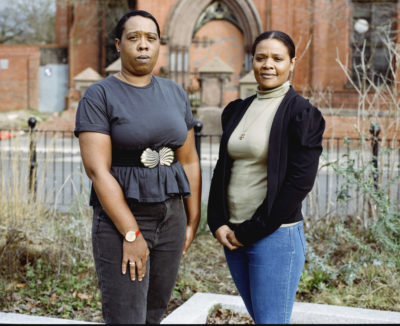St Paul of the Cross, the founder of the Passionists, was known for his desire to teach people to pray, and share what he had experienced. How do we pray? What role does prayer take in our lives? We asked three people pursuing a Passionist spirituality how their sense of prayer has changed over time.
Michael O’Halloran
Michael O’Halloran is a member of the Community of the Passion working at St Antony’s Priory, Durham
My first memory of anything related to prayer was aged six, being taught by my teacher how to receive Holy Communion for the first time. We practised using wafers, the type I usually associated with a slice of ice cream. We were warned not to chew the host, not to let it linger in mouth, lots of do nots. Fear and superstition were to be ever-present prayer companions for many years.
I grew up in a community in the west of Ireland, where being Irish and Catholic were inseparable. To my young eyes, it seemed a self-assured community, one where there was an abundance of volunteer-led community activities. The God whom I met in my Catholic school and Parish Church was a loving God. Our priests were kind, and involved in the community at all levels.
Predictably, earlier years were about learning to say prayers, memorising them, developing habits. Confession was treated as my ‘get out of jail free’ card; I heard the instruction to ‘not sin again’ but gave more weight to the knowledge that God will forgive not just seven times, but up to seventy times seven (Luke 17). I approached life, like most young people, with the attitude that there was plenty of time to get better at this sinning stuff.
In this environment, I had an innate feeling that my emerging awareness of being gay had to be kept quiet. Prayer took a different turn at this point; I bargained with God to make me ‘normal’. I have come to realise that this is a common experience for most teenagers—the pressure we all feel to ‘fit in’ is compounded by a feeling of being different. As the years have passed, I have treasured my difference, and pondered how this manifests in being created in the image and likeness of God.
•
At seminary, St Patrick’s College, Maynooth, I learned not just what we believed as Catholics but why we believe. I learned about liturgy as a way of praying. The formal Sunday masses with their wafts of incense and sung Gospels were nothing like I had experienced in my Parish. I was drawn into the mystery of the Eucharist.
Another first for me was the introduction to the Prayer of the Church, also known as the Liturgy of the Hours. For us junior seminarians, this meant praying together morning, evening, and night prayer. It was the first time I prayed with the Psalms. Up until then, a psalm was something squeezed in between the scripture readings at mass. In the liturgy of the hours, here all 150 of them were laid out—and they have been a constant in my prayer ever since.
O God, you are my God,
for whom I have been searching earnestly.
My soul yearns for you
and my body thirsts for you,
like the earth when it is parched,
arid and without water. (Ps63:2)
I also learned how to be still during Saturday night Eucharist adoration. It didn’t come easily; I usually had to bring a book with me to help the hour pass, but it has become an enduring element of prayer for me.
Peter Van Breemen wrote in As Bread That is Broken: “Prayer is a waiting. Waiting places, the emphasis on the other person who is coming. I can only wait for this person. To wait is to express my powerlessness, my insufficiency, and that is my attitude towards God. I cannot force God to come. All I can do is wait and be present.” This speaks to me about the attitude I try to bring to prayer: less about me and what I need to do. It’s a challenge for me, someone with a deep-seated need to get things right, to do prayer the ‘right’ way.
•
Leaving the seminary was the right decision, but it was the beginning of a very difficult period of my life. Like any relationship, my relationship with God and with prayer had its ups and downs. I did not want to pray; I was angry with God, how a loving God could have had me believe that I would be a priest. I did not then understand that my time in seminary was fruitful formation in my relationship with God.
Moving to London, I occasionally tried to go to church but found myself isolated in a structure that revolved around families of two heterosexual parents and their children. I started visiting Benedictine monasteries for retreats, attracted to their singing of the Liturgy of the hours. The spirituality of St Benedict was one of a number of spiritualities that have helped me to experience a variety of ways of praying.
“The challenge is my deep-seated need to do prayer the ‘right’ way.”
Turning thirty, I found myself in need of the spirituality of the twelve-step programme. The Trappist Monk Thomas Keating, speaking about the programme, says “You are just open to the possibility that God is not the way you think God is, from your particular cultural background or human experience thus far. In actual fact, God is existence and must be present in everything that is.” For me, surrendering was a shift into a different experience of God, both simpler and deeper. Richard Rohr believes that ‘Jesus and the Twelve Steps of Alcoholics Anonymous are saying the same thing but with different vocabulary: We suffer to get well. We surrender to win. We die to live. We give it away to keep it.’
I practised the twelve-step spiritual programme, praying the Step Three and Seven prayers daily for about six years, when I realised I was saying these prayers out of fear. Fear that if I didn’t say them, God would abandon me, and I would lose my ability to live a sober life. With that awareness of my superstitious approach to prayer, it was available to me to choose instead to bring those prayers to God in gratitude and faith.
As a result, I hope I now approach prayer and life with something approaching the attitude of Ganga in This is Happiness (Niall Williams); “Story was the stuff of life, and to realise you were inside one allowed you to sometimes surrender to the plot, to bear a little easier the griefs and sufferings and to enjoy more fully the twists that came along the way.”
•
My prayer story continued into undergoing the full Ignatian Spiritual Exercises. Out of that intensive, prayerful retreat, I have tried to hold onto two questions: what might my life and experience of God be like, if I could understand even a fraction of how I am desired and loved by God? What if I, in turn, could love God’s Creation even a fraction of the way in which God loves?
The Spiritual Exercises are a pilgrimage of knowing, following and loving Jesus more and more. Ignatian prayer has introduced me to a variety of ways to pray: imaginative prayer is a very active way of praying, usually with scripture, that engages the mind and heart and stirs up thoughts and emotions; the Examen, a way of praying from the early church, ensures my focus is on the way God is relating to me in the day; the Colloquy, an intimate conversation between me and God, Jesus, Mary or any of the Saints as one friend to another.
Through the Passionist priest, John Sherrington, I was witness to an embodied Passionist Spirituality. My prayer has become more contemplative, and I am sustained in my work as a Spiritual Director and Counsellor by being drawn ever deeper into the mystery of Christ’s passion.
I now often contemplate the image of the Pieta: Mary holding the crucified Jesus, simultaneously bearing witness to both the suffering of her son and her own suffering. A symbol to me that I cannot be with the suffering of another unless I am unafraid to encounter my suffering; and I can only be unafraid when I surrender my life to the care of God, nurtured through prayer.
Read part two (Bishop William Kenney) and part three (Joanne Crompton).
Related Stories

Experiences of Passionist prayer, pt. 3: Joanne Crompton
How do we pray? What role does prayer take in our lives? We asked three people pursuing a Passionist spirituality how their sense of prayer has changed over time.
Jul 05 2023

Experiences of Passionist prayer, pt. 2: Bishop William Kenney
How do we pray? What role does prayer take in our lives? We asked three people pursuing a Passionist spirituality how their sense of prayer has changed over time.
Jun 24 2023

Change Everything: Why Reformed are transforming lives for prison leavers
Kemi and Natasha Ryan are the epitome of the DIY start-up. Their organisation, Reformed, is a ground-up, first-hand mentoring service working with prison leavers, helping them to find a path back to work and a fuller life.
Apr 10 2023

